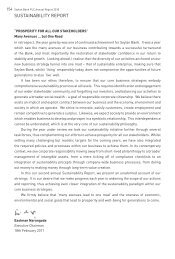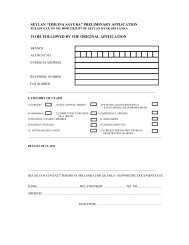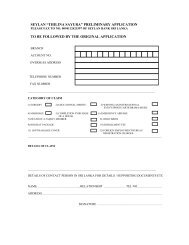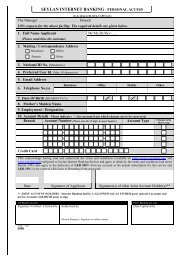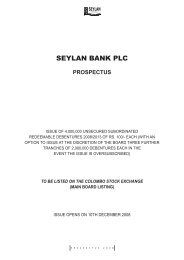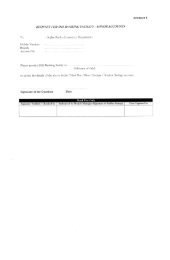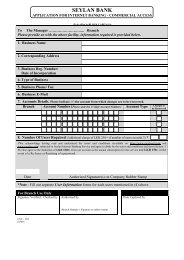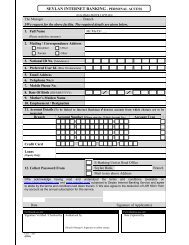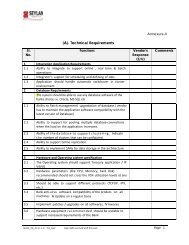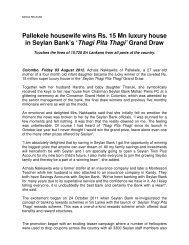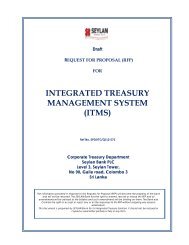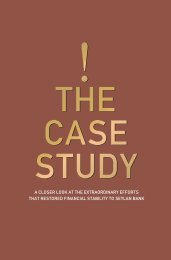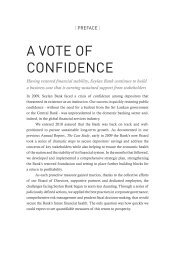Notes to the Consolidated Financial Statements - Seylan Bank
Notes to the Consolidated Financial Statements - Seylan Bank
Notes to the Consolidated Financial Statements - Seylan Bank
Create successful ePaper yourself
Turn your PDF publications into a flip-book with our unique Google optimized e-Paper software.
North Bound > <strong>Seylan</strong> <strong>Bank</strong> Annual Report 2011<br />
279<br />
Depreciation of common types of assets within <strong>the</strong> Group is in line with <strong>the</strong> Group policy disclosed<br />
above. Freehold land is not depreciated. Leasehold land and buildings are depreciated over <strong>the</strong> remaining<br />
unexpired lease period. The depreciation of o<strong>the</strong>r assets that are unique <strong>to</strong> <strong>Seylan</strong> Developments PLC is<br />
provided on <strong>the</strong> straight-line method at varying rates per annum, based on <strong>the</strong>ir useful lives as follows:<br />
Useful Life (years) Depreciation Rate(%)<br />
Furniture & Fittings 10 10<br />
Equipment 05 20<br />
Interior Décor 02 50<br />
Mo<strong>to</strong>r Cars 05 20<br />
Mo<strong>to</strong>rcycles 04 25<br />
Tools 03 33 1/3<br />
Cutlery & Crockery 02 50<br />
3.3.7 Intangible Assets<br />
3.3.7.1 Goodwill<br />
Goodwill that arises upon <strong>the</strong> acquisition of subsidiaries is included in intangible assets. The Group<br />
measures goodwill as <strong>the</strong> fair value of consideration transferred less <strong>the</strong> net amount of identifiable assets<br />
acquired and liabilities assumed, all measured as of <strong>the</strong> acquisition date. When <strong>the</strong> excess is negative, <strong>the</strong><br />
gain is recognised immediately in o<strong>the</strong>r income. The Group has elected <strong>to</strong> <strong>the</strong> above method for changes in<br />
ownership interest in an existing subsidiary as well.<br />
3.3.7.2 Software<br />
Software acquired is stated at cost, less accumulated amortisation and accumulated impairment losses.<br />
Subsequent expenditure on software assets is capitalised only when it increases <strong>the</strong> future economic<br />
benefits embodied in <strong>the</strong> specific asset <strong>to</strong> which it relates. All o<strong>the</strong>r expenditure is expensed as incurred.<br />
Amortisation is recognised in profit or loss on a straight-line basis over <strong>the</strong> estimated useful life of <strong>the</strong><br />
software, from <strong>the</strong> date that is available for use since this most closely reflects <strong>the</strong> expected pattern of<br />
consumption of <strong>the</strong> future economic benefits embodied in <strong>the</strong> asset. The estimated useful life of software<br />
is as follows:<br />
Component Useful Life (years)<br />
<strong>Seylan</strong> <strong>Bank</strong> PLC 6<br />
<strong>Seylan</strong> Developments PLC 5<br />
3.3.8 Capital Work-in-Progress<br />
Capital work-in-progress is stated at cost. These are expenses of a capital nature directly incurred in <strong>the</strong><br />
construction of buildings, major plant and machinery and system development, awaiting capitalisation.<br />
3.3.9 Borrowing Costs<br />
Borrowing costs that are directly attributable <strong>to</strong> <strong>the</strong> acquisition, construction or production of a qualifying<br />
asset have been capitalised as part of <strong>the</strong> cost of <strong>the</strong> asset in accordance with Sri Lanka Accounting<br />
Standard 20 - ‘Borrowing Costs’. Capitalisation of borrowing costs ceases when substantially all <strong>the</strong><br />
activities necessary <strong>to</strong> prepare <strong>the</strong> qualifying asset for its intended use are completed.



